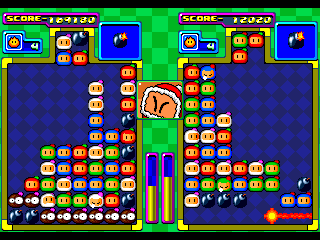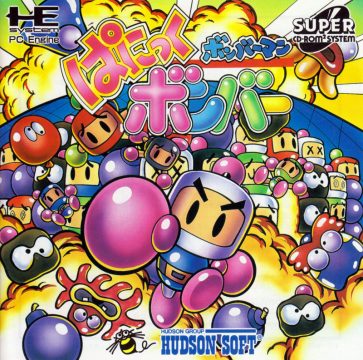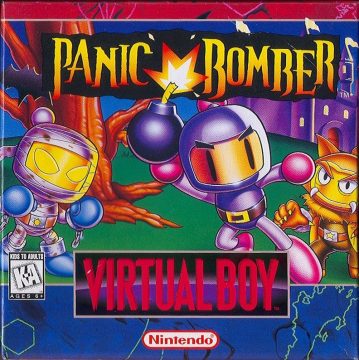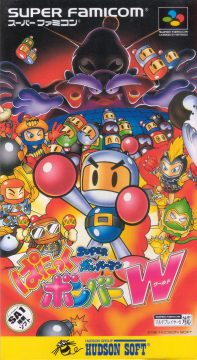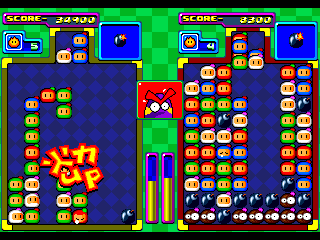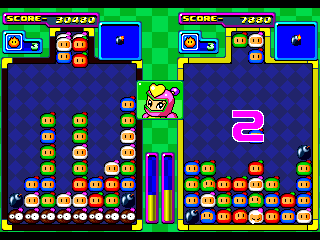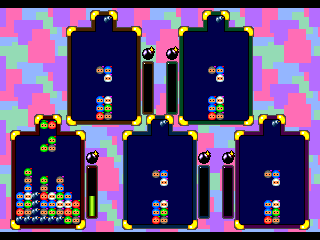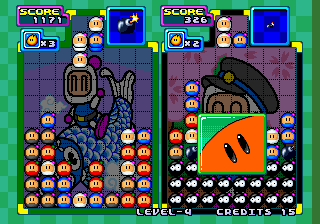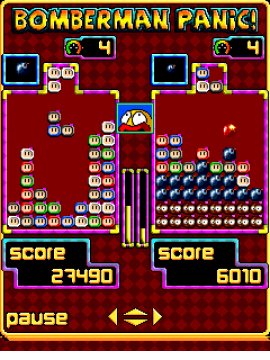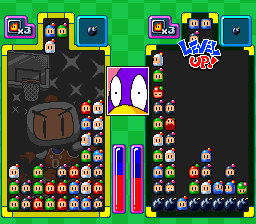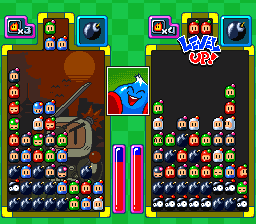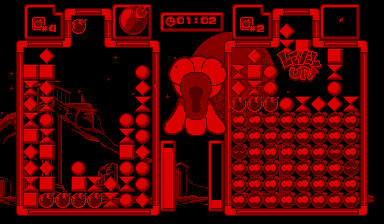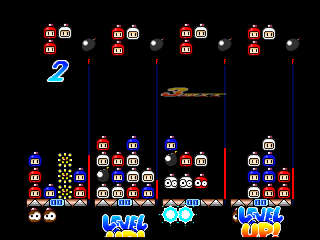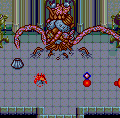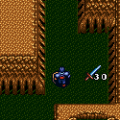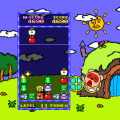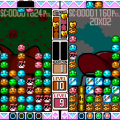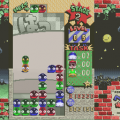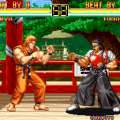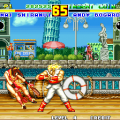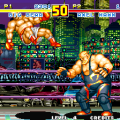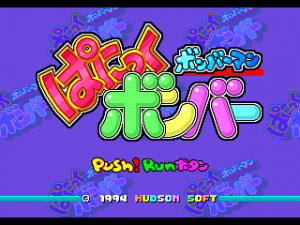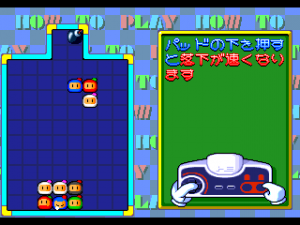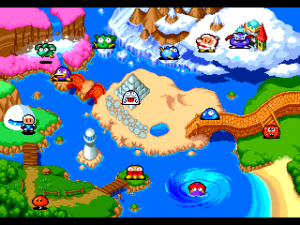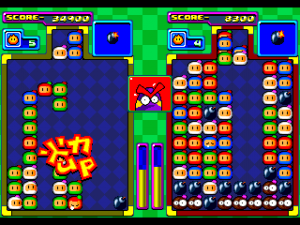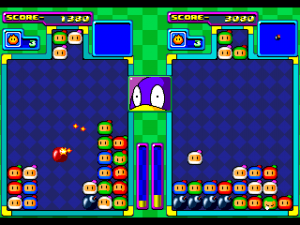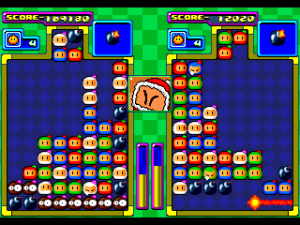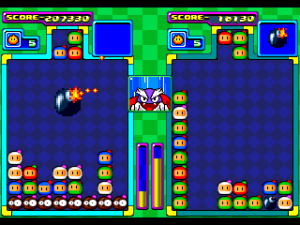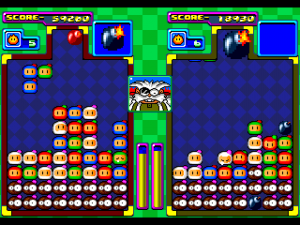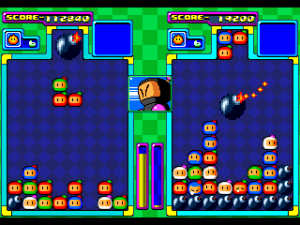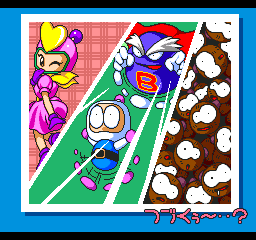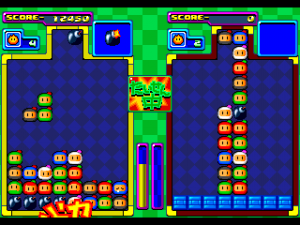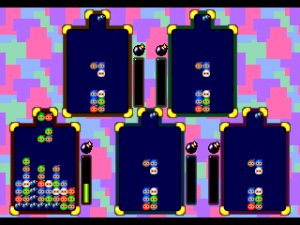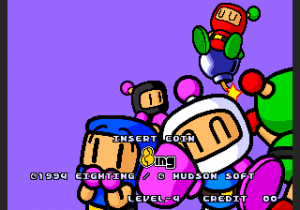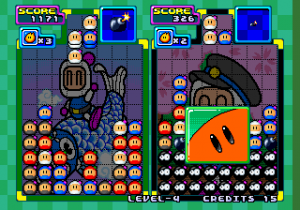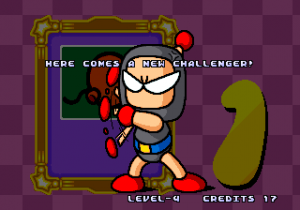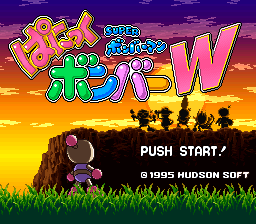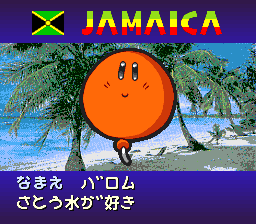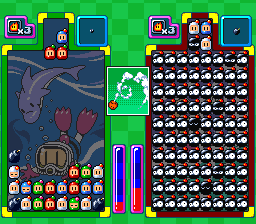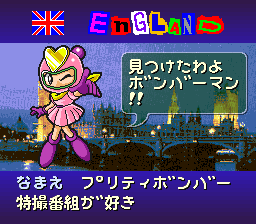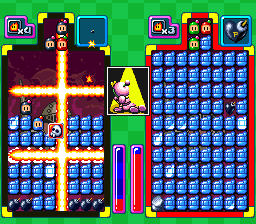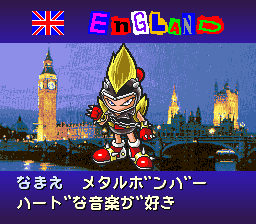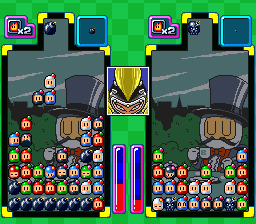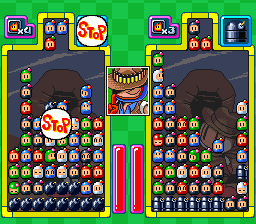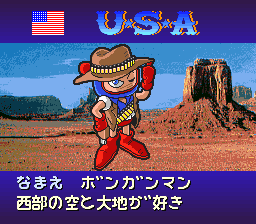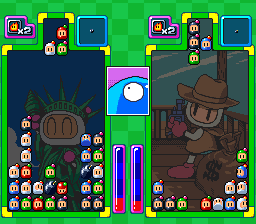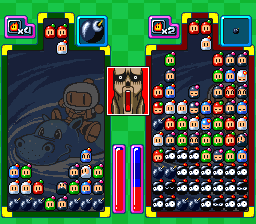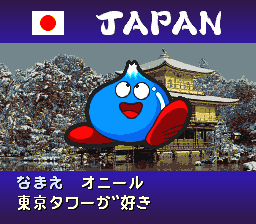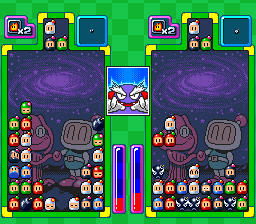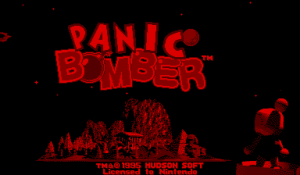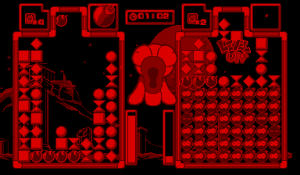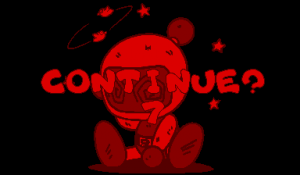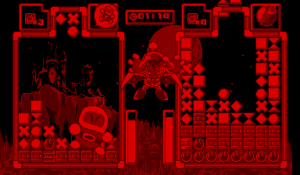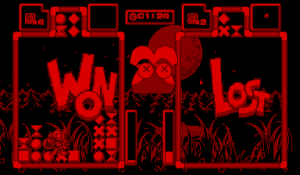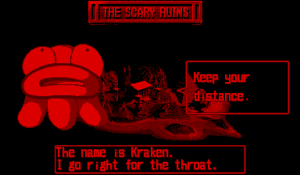- Bomberman Series Introduction / Bomberman (1983)
- 3-D Bomberman
- Bomberman (1985)
- RoboWarrior
- Atomic Punk
- Bomberman (1990)
- Atomic Punk (Arcade)
- Bomberman II
- New Atomic Punk: Global Quest
- Bomberman ’93
- Super Bomberman
- Hi-Ten Bomberman / Hi-Ten Chara Bomb
- Bomberman ’94 / Mega Bomberman
- Super Bomberman 2
- Super Bomberman 3
- Wario Blast: Featuring Bomberman
- Bomberman GB 2
- Bomberman: Panic Bomber
- Super Bomberman 4
- Saturn Bomberman
- Bomberman GB 3
- Bomberman B-Daman
For the first Bomberman spin-off since RoboWarrior, Hudson Soft decided to take a crack at the ever-reliable “falling block” puzzle game genre, specifically ones in the vein of Puyo Puyo. It might sound like an unusual idea, taking a franchise that’s partially about destroying blocks and instead asking players to stack them for a bit before letting loose with their explosives, but Panic Bomber manages to establish a distinct identity for itself that makes it worth visiting even today. While some future Bomberman spin-offs failed to get more than a few iterations at most, Panic Bomber managed to get unique entries through the early 2000s and still endures to a small degree thanks to relatively recent ports on things like the Wii U Virtual Console in 2017 and the PC Engine Mini in 2020.
The PC Engine CD version of Panic Bomber, the first to hit the market, features little in the way of plot and instead focuses more on celebrating the franchise’s popular characters by putting them all in one place. Over the course of 16 levels, you’ll encounter several foes from almost every Bomberman game up to Super Bomberman 2, such as Ballom, Telpio, and Pass. Bagura is here once again to try and put a stop to Bomberman’s fun, though he’s not the only villain you’ll face; you’ll also get to encounter Golem Bomber, Pretty Bomber, Black Bomberman, and a new scientist that never appears again. They’re not the same, but it’s possible that this scientist was a template of sorts for Dr. Mechado, a future villain that appears in Saturn Bomberman and Bomberman Jetters. Your progress through the story mode is depicted on a colorful map that Bomberman crosses to encounter new opponents, which does a lot to add to the scope of the game – Panic Bomber feels bigger and more robust than many of its contemporaries while also retaining much of the main series’ flavor thanks to its presentation and diversity of modes.
Much like Baku Baku Animal or Pac-Attack, gameplay in Panic Bomber is a two-step process. First, you need to stack the multi-colored Bomberman heads that fall from the top of the screen. Three or more of the same color make a match and will get cleared out (this can also be done diagonally), but clearing out heads won’t actually send garbage (depicted as exploded bombs with cute googly eyes here) to the opposing player. Instead, matching Bomberman heads will create unlit bombs at the bottom of the screen. The better the combo, the more bombs appear, making combo skills as important as usual for the genre if you want to be an effective combatant. To deal some real damage, you’ll have to make as many matches and combos as you can, then wait until a bomb with a lit fuse appears and use that to blow up as many unlit bombs as possible. The more bombs you blow up, the more garbage gets sent to the opposing player and the more space you get back on your playing field, giving the aggressor a twofold advantage. As you accumulate combos and blow things up, you’ll build up a meter that, when full, allows you to drop down a massive bomb that can destroy most or all of the playing field depending on where you place it. Anything destroyed by this bomb contributes to the load of the garbage sent your opponent’s way too, which means that the outcome of games can often come down to whoever gets their big bomb first.
The flow of Panic Bomber is riveting in that players will intentionally teeter between the brink of defeat and the cusp of victory throughout matches based on their game plan and the duration of the match. You need as many bombs as possible to deal damage to your opponent, but holding onto rows of unlit bombs means that you’ll have less space to maneuver and match heads. If you wait too long to blow them up, though, your lit bombs may not have enough firepower to reach them once they’re buried underneath layers of heads and garbage. Both players’ firepower will naturally increase as matches go on, but surviving to a point where your firepower gets high enough to engulf entire columns can be easier said than done. The shape of the playing field works very much to the advantage of players who understand how to use it; you only lose if the middle columns fill up and block the bottleneck at the top, which means that you can stack things on the sides to your heart’s content. While there’s plenty of room for user error and improvisation, rounds of Panic Bomber can end up feeling very similar to each other because of this – the strategy often comes down to stacking and doing combos on the sides, hoarding bombs for at least a little while so you can maximize your offensive efficiency, then blowing them all up to bury your opponent and hopefully get the giant bomb before they recover from your previous attack.
Fitting in with the game’s theme of being a series-wide tribute, the graphics of the PC Engine CD version harken back to previous entries on the platform and will immediately look familiar to anyone who has played the 1990 game or Bomberman ’93 in particular. This does mean that Panic Bomber doesn’t make use of the new storage format for anything elaborate like cutscenes, but its overall look is still plenty charming thanks to the character portraits that animate and change expression based on how matches go. The CD format is more heavily utilized for the game’s audio, allowing this entry to be the first one to have voice acting. “Voice acting” is perhaps a bit generous considering the only audio is for Bomberman and his foes making grunts and other noises during gameplay, but that didn’t stop Hudson Soft from hiring notable actors for the job. White Bomberman is voiced by Kazuko Sugiyama, a renowned actress who has had plenty of notable roles in anime such as Urusei Yatsura (Ten) and Gatchaman (Jun the Swan), and she would go on to voice Bomberman in several more of his games throughout the 90s including Super Bomberman 4 and 5, Saturn Bomberman, and Bomberman Fantasy Race.
Aside from the story mode, there’s also a mode called “Road to Boba Temple” that works as a challenge mode for those who are confident in their skills. Over the course of 50 floors, you’re given challenges to complete, such as getting combos of a certain length or clearing out a certain number of heads before time runs out. While the lack of a story beyond the ending screen, visual variety (aside from an attractive illustration that serves as a title screen for the mode) or characters to encounter can make it feel repetitive, it’s a great place to go for those looking to test their skills in a different way compared to the usual 1v1 setting.
As any Bomberman game released at this point in time should, Panic Bomber allows for up to five people to compete with each other. Naturally, having to share the screen with five people means that many of the game’s usual visual elements need to be removed to make everyone fit alongside the shrunken playing fields, but the tradeoff allows for some enjoyable chaos as players frantically work to stay afloat while dealing with garbage from multiple directions. Multiplayer mode also allows for Skull/Dokuro mode to be activated, which brings power-ups back into the fray. In this mode, garbage becomes soft blocks instead and when you blow them up, you’ll receive some kind of power-up that’ll either make your life easier or ruin your opponent’s day. These power-ups include things like removing heads or bombs from the field, sending special hard blocks to your opponent’s side that can only be destroyed with the big bomb, and even stopping the opponent from doing anything for five seconds, which is exactly as devastating as it sounds. Skull mode throws in a new wrinkle that can make for more challenging and unpredictable matches as you react to setbacks that wouldn’t normally exist, but the power-ups it introduces can sometimes feel so powerful as to be the primary determining factor for the outcome of a match, which is something that likely won’t appeal to those looking for a more standard, competitive playfield.
The original version of Panic Bomber has received several other versions, each with their own compromises compared to the robustness of the source material. A Neo Geo MVS arcade version was published by Eighting and released in January 1995, almost immediately after the PC Engine release, as these versions were developed in tandem. This version is much lighter compared to the PC Engine version as it’s missing seven levels from the single player mode, removes the Road to Boba Temple mode, gets rid of the map, and ends with Bagura instead of the scientist. Only two players at a time are supported, but players can now challenge each other to battle at any time during single player, complete with an animation of Black Bomberman angrily gearing up for a fight! This version still manages to look and sound excellent thanks to new flourishes like bigger character portraits, a remixed soundtrack, and new backgrounds that change as players power up. These backgrounds are very cute, depicting Bomberman doing various things like riding a fish or playing baseball, so they make for a great secondary reward to go with your power boost. This version got a North American release too, making it the region’s first official exposure to Panic Bomber.
Later in 1995, Panic Bomber was ported to the PC-98 and the FM Towns and these versions are nearly identical to the arcade version, even including the same amusing intro of the Bombers getting blown up. These versions only feature nine stages and cut down on the options in much the same way, but they also suffer from additional compromises, such as the removal of enemy portraits (replaced with a still image of your opponent in the background) and fewer music tracks, though the tracks on offer are at least new and still enjoyable. The new background images look rough around the edges too, with Bagura’s being the most bizarre due to his body being cloaked in red instead of purple as if his cape somehow covered his entire body and also had sleeves. A Sharp X68000 version also exists, though it appears to be undumped and there isn’t much information on it beyond some box art images.
Panic Bomber made its way to Java-supported devices in 2001 (as Bomberman Panic!) and it’s a better port than one might expect. This is the port of the PC Engine CD version that retains the most of its features (except the multiplayer), which is genuinely impressive considering how versions on stronger hardware made more cuts. Of course, to make it work on Java devices, many audiovisual compromises had to be made, including simplified animations, an ugly new UI, and a single music track with an extremely short loop for the entire game. An updated version of this port, called Panic Bomber Original, was released in 2004 and a multiplayer version called Taisen☆ Panic Bomber followed it in 2006. The Taisen version supposedly offered visual enhancements and online battles for 2-4 players, but very little evidence of its existence is available on the internet and the game is no longer playable.
Super Bomberman: Panic Bomber W
Not only is Panic Bomber W a new version of the game and not a port, it also fits into the Bomberman canon as a sequel to Super Bomberman 2. Hot off the heels of his victory against the Five Dastardly Bombers, a new threat rears its head to interrupt Bomberman’s vacation – The World Bombers! Made up of five new bombers mean to represent five regions of the real world (Jamaica, England, USA, Kenya, and Japan), these villains mean business and intend to cause havoc all over the globe. Thanks to a more robust Story Mode that introduces dialogue before and after battles, the plot gets some proper expansion as you go. It turns out that the World Bombers are being controlled by an external force, and where the story ends depends on your performance. If you’re playing on a lower difficulty, your game will end anticlimactically with Bagura, but if you’re playing on the higher difficulties or encounter and defeat Pretty Bomber and the “new” Shadow Bomber (which is just Black Bomberman masquerading as a ninja), you’ll get to fight Space Bomber, the true mastermind of the game, and earn a proper ending.
Panic Bomber W was developed by Raizing instead of Hudson Soft and the difference in staff shows. The game was directed by Masato Toyoshima, who would go on to be a producer for the Bloody Roar series, and you can feel a bit of fighting game energy in Panic Bomber W once you get the hang of it. It’s faster, more frenetic, has both a learning curve and a high skill ceiling, and it’s the kind of game where experts can really style on their foes and end matches in the blink of an eye. While the presentation of the original version was strong, Panic Bomber W is exceptionally vibrant and charming thanks to the efforts of Shigeki Fujiwara (who directed Bomberman ’93), who puts the wildly different “world warrior” theming to proper use with illustrations for each region and a host of colorful characters both new and old.
Each region has its own music for regular battles and each World Bomber gets a unique theme as well. Rasta Bomber of Jamaica is backed by a smooth reggae track, Metal Bomber in England has intense thrash metal music playing as you two butt heads, and the track used for Japan’s Karaoke Bomber makes it sound like he’s singing Enka as you do battle.The soundtrack is overall exceptional thanks to the dream team-esque combination of Jun Chikuma, Kenichi Koyano (Bloody Roar) and Hitoshi Sakimoto (Final Fantasy Tactics, Tactics Ogre, Vagrant Story). The rotating backgrounds from the arcade game return as well and each region gets a unique batch. A lot of these hit stereotypes that are so narrow and naïve as to be amusing, including things like the USA being depicted purely by cowboys, basketball, and the Statue of Liberty and England having Bomberman drinking tea while wearing a top hat and monocle.
Panic Bomber (Virtual Boy)
Nintendo’s Virtual Boy didn’t receive much in the way of third party support during its short life for variety of reasons that aren’t too hard to surmise, but Hudson Soft decided to bless it with a Bomberman entry nonetheless. You could argue that putting a spin-off title on there instead of a main entry was Hudson Soft “hedging their bets” with the expectation of lackluster sales, but Panic Bomber works quite well on the platform and clearly had the same level of effort put into it as any of the previous versions. Though the loss of multiplayer due to the Virtual Boy’s link cable never releasing is unfortunate, this version of the game still offers a unique, full-fledged story mode in the same vein as Panic Bomber W.
This time around, Panic Bomber takes Bomberman to the mysterious Ever-Mist Island where the Golden Bomber statue is guarded by four masters of the island. This game introduces a monster movie theme for its new Bombers, including the likes of a werewolf, a mummy, Frankenstein’s monster, and Dracula. Like with Panic Bomber W, satisfying specific criteria allows the player to encounter Pretty Bomberand earn the true ending. To go along with the theme, the dialogue for each character is much darker in tone, with most of the characters threating violence towards Bomberman or otherwise trying to intimidate him. It’s extremely bizarre and ineffective considering the characters still look as cute as they usually do, but the fact it’s trying so hard makes it rather endearing. Several character names were changed for the English localization in ways that don’t make much sense. Pretty Bomber was changed to “Ms. Flash”, the other Bombers had their names shortened to sound more ordinary (eg. Bomber Wolf -> Zach, Monster Bomber ->Partz), and the other Bomberman enemies had their names changed as well.
In Japan, the game was called Tobidase! PaniBom, which was a name meant to represent the game’s 3D capabilities and visuals (Tobidase meaning “to jump out”). The Virtual Boy was capable of putting out some excellent visuals and Panic Bomber is no exception. Instead of small portraits, characters have massive and smooth full body animations that change based on how the battle is going. The cutscenes use the Virtual Boy’s 3D capabilities to create an unusual aesthetic that makes Bomberman look like he’s a guy in a suit or a clay model. The lack of colors beyond red and black seem like they’d be a major playability problem, but this entry thankfully allows you to change the appearance of the blocks into other shapes. In particular, the option to change them into shapes like squares, diamonds, and spheres comes highly recommended.
Panic Bomber (PSP)
The 2005 entry of Panic Bomber for the PSP serves as the first of several Bomberman titles to end up on the platform, arriving early in its life exclusively in Japan. Instead of the exuberant variety of the Super Famicom game or the horror movie theming of the Virtual Boy title, Panic Bomber on PSP goes all-in on slickness and modernity, paring things down as far as possible while keeping the focus on the main Bombers. This results in an interface that’s undeniably clean and snappy while still maintaining plenty of color, but is also lacking in the same personality as its predecessors. This extends to its modes as well; instead of a story mode, you get a “Vs CPU” mode, a score attack mode, and a challenge mode. The challenge mode is similar to the Road to Boba Temple mode in the original game and the score attack mode lets you play by yourself for points as the game speed gradually increases. Multiplayer is also possible with other players who have a copy of the game, but the lack of online play is starkly noticeable and would have done a lot to give it an edge over previous releases at the time.
The VS CPU mode is the closest thing to a main game and has you facing off against the Black, Red, Blue, and Green Bombers in five matches of gradually increasing difficulty. Each match gradually improves the enemy AI, adds in Skull/Dokuro mode, and starts the player off with a pre-arranged setup of heads and garbage that serves as a potential handicap. Beating them all five times each unlocks the final opponent, which is a lone HigeHige Bandit. It’s downright bizarre that Bagura or Mujoe, the leader of the HigeHige Bandits, weren’t picked instead, but considering that this mode has no story or dialogue, it ultimately doesn’t affect much. While defeating the CPU and playing the game is as fun as it usually is, especially with the added wrinkles of the pre-built stages requiring you to find solutions to make matches fair again, the game loses a lot of personality and memorability by forgoing a story and dialogue. Once you’ve beaten the CPUs, there’s really no reason to return to the mode since there aren’t any alternate endings to discover or higher difficulties to play.
Defeating the CPUs and doing well in the other modes earns you unlockable backgrounds, block replacements, playing field skins, and sound effects, which can be customized to your liking. This is the game’s most compelling improvement over past versions and there’s fun to be had in seeing what you unlock. The backgrounds are varied and pretty and some of the block replacements are amusing, including pieces of sushi and various dog heads. Even with this incentive, there aren’t many things to unlock and it’s reasonable to get most of it in a couple of hours, making this game feel slimmer than it should considering the era of gaming it released in.
Other Appearances
Panic Bomber found its way into other Bomberman titles as a bite-sized part of a bigger package. In Bomberman 64 (the Japan-exclusive 2001 game, not the 1997 game), Panic Bomber can be played in a score attack format (just like the PSP game) or as a multiplayer game with up to four people. This implementation of the game is exactly as no-frills as it sounds, even going as far as to exchange the background for a black screen when playing in multiplayer, but it works as a quick and functional way to set up a game of Panic Bomber should the opportunity arise.
2003’s Bomberman Land 2 features the game as a separate mode as well and it’s exactly the same in the modes it features. The only change here (aside from the presentation) is a new feature that causes bombs to automatically explode whenever heads are matched. This fundamentally changes the way the game is played since you no longer get the chance to stack bombs for big damage, making for a less interesting game. In the same year, Panic Bomber was also included in the BombermanJetters Game Collection and is mechanically the same as the Bomberman Land 2 version. The main difference here is in the presentation, which is themed around Bomberman’s ally Dr. Ein and curiously exchanges the Bomberman heads for colored circles with no option to switch them.
Links
https://www.itmedia.co.jp/mobile/articles/0406/15/news069.html – Information on the mobile version
https://www.youtube.com/watch?v=EB0C6bvDZWA – Playthrough of the FM Towns version
https://wikiwiki.jp/brew/%E5%AF%BE%E6%88%A6%E2%98%86%E3%81%B1%E3%81%AB%E3%81%A3%E3%81%8F%E3%83%9C%E3%83%B3%E3%83%90%E3%83%BC – Information on Taisen☆ Panic Bomber
https://randomhoohaas.flyingomelette.com/bomb/mob/ – Has a screenshot + a bit of information on Taisen☆ Panic Bomber
